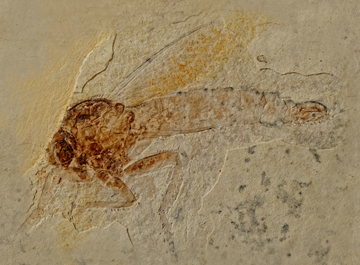Abstract
The dysagrionid damselflies, characterized by a broad quadrilateral discoidal cell, are widely recorded in the Lower Cretaceous–lower Oligocene, and frequently found in mid-Cretaceous Kachin amber (Zheng et al., 2016, 2017a, b, 2018a). Three genera and four species of Dysagrionidae have been described from Kachin amber, including Burmadysagrion zhangi Zheng, Wang & Nel, 2016, Electrodysagrion lini Zheng, Nel & Wang, 2017, Palaeodysagrion cretacicus Zheng et al., 2017 and Palaeodysagrion youlini Zheng, Chang & Wang, 2018 (Zheng et al., 2016, 2017a, b, 2018a). The dysagrionid damselflies have several types of discoidal cells seen in the Kachin amber species, contributing to evaluating the early evolution and diversification of the discoidal cell. For example, Burmadysagrion has the anterior and posterior sides of the discoidal cell not parallel, and the basal side longer than the distal side; Electrodysagrion has the anterior and posterior sides of the discoidal cell not parallel, and distal side longer than the basal side; and Palaeodysagrion has a long and narrow discoidal cell. In the present paper, a new dysagrionine damselfly is described representing the second dysagrionine in Kachin amber. The new damselfly allows for the revision of the generic characters of Electrodysagrion Zheng, Nel & Wang, 2017.
References
Bechly, G. (1996) Morphologische Untersuchungen am Flügelgeäder der rezenten Libellen und deren Stammgruppenvertreter (Insecta; Pterygota; Odonata), unter besonderer Berücksichtigung der Phylogenetischen Systematik und des Grundplanes der Odonata. Petalura, 2, 1–402.
Cockerell, T.D.A. (1908) Fossil insects from Florissant. Bulletin of the American Museum of Natural History, 24, 59–69.
http://hdl.handle.net/2246/939
Fabricius, J.C. (1793) Entomologia systematica emendata et aucta, secundum classes, ordines, genera, species, adjectis synonymis, locis, observationibus, descriptionibus. C.G. Proft, Hafniae, 3, 1–488.
https://doi.org/10.5962/bhl.title.122153
Nel, A., Martinez-Delclòs, X., Paicheler, J.C. & Henrotay, M. (1993) Les ‘Anisozygoptera’ fossiles. Phylogénie et classification (Odonata). Martinia Hors Série, 3, 1–311.
Riek, E.F. & Kukalová-Peck, J. (1984) A new interpretation of dragonfly wing venation based upon Early Carboniferous fossils from Argentina (Insecta: Odonatoidea) and basic character states in pterygote wings. Canadian Journal of Zoology, 62, 1150–1166.
https://doi.org/10.1139/z84-166
Selys-Longchamps, E.de. (1854) Monographie des calopterygines. Mémoires de la Société Royale des Sciences de Liège, 9, xi + 291 pp.
https://doi.org/10.5962/bhl.title.60461
Shi, G., Grimaldi, D.A., Harlow, G.E., Wang, J., Wang, J., Wang, M., Lei, W., Li, Q. & Li, X. (2012) Age constraint on Burmese amber based on U-Pb dating of zircons. Cretaceous Research, 37, 155–163.
https://doi.org/10.1016/j.cretres.2012.03.014
Zheng, D.R., Wang, B., Jarzembowski, E.A., Chang, S.C. & Nel, A. (2016) Burmadysagrioninae, a new subfamily (Odonata: Zygoptera: Dysagrionidae) from mid-Cretaceous Burmese amber. Cretaceous Research, 67, 126–132.
https://doi.org/10.1016/j.cretres.2016.07.006
Zheng, D.R., Chang, S.C., Nel, A., Jarzembowski, E.A., Zhuo, D. & Wang, B. (2017a) Electrodysagrion lini gen. et sp. nov., the oldest Dysagrionini (Odonata: Zygoptera: Dysagrionidae) from mid-Cretaceous Burmese amber. Cretaceous Research, 77, 44–48.
https://doi.org/10.1016/j.cretres.2017.05.008
Zheng, D.R., Zhang, Q.Q., Nel, A., Jarzembowski, E. A., Zhou Z., Chang, S.C. & Wang, B. (2017b) New damselflies (Odonata: Zygoptera: Hemiphlebiidae, Dysagrionidae) from mid-Cretaceous Burmese amber. Alcheringa: An Australasian Journal of Palaeontology, 41, 12–21.
https://doi.org/10.1080/03115518.2016.1164402
Zheng, D.R., Chang, S.C. & Wang, B. (2018a) A new dysagrionid damselfly (Odonata: Zygoptera: Palaeodysagrion) from mid-Cretaceous Burmese amber. Alcheringa: An Australasian Journal of Palaeontology, 42, 300–304.
https://doi.org/10.1080/03115518.2017.1381991
Zheng, D.R., Chang, S.C., Perrichot, V., Dutta, S., Rudra, A., Mu, L., Kelly, R.S., Li, S., Zhang, Q., Zhang, Q.Q., Wong, J., Wang, J., Wang, H., Fang, Y., Zhang, H.C. & Wang, B. (2018b) A Late Cretaceous amber biota from central Myanmar. Nature Communications, 9, 3170.

